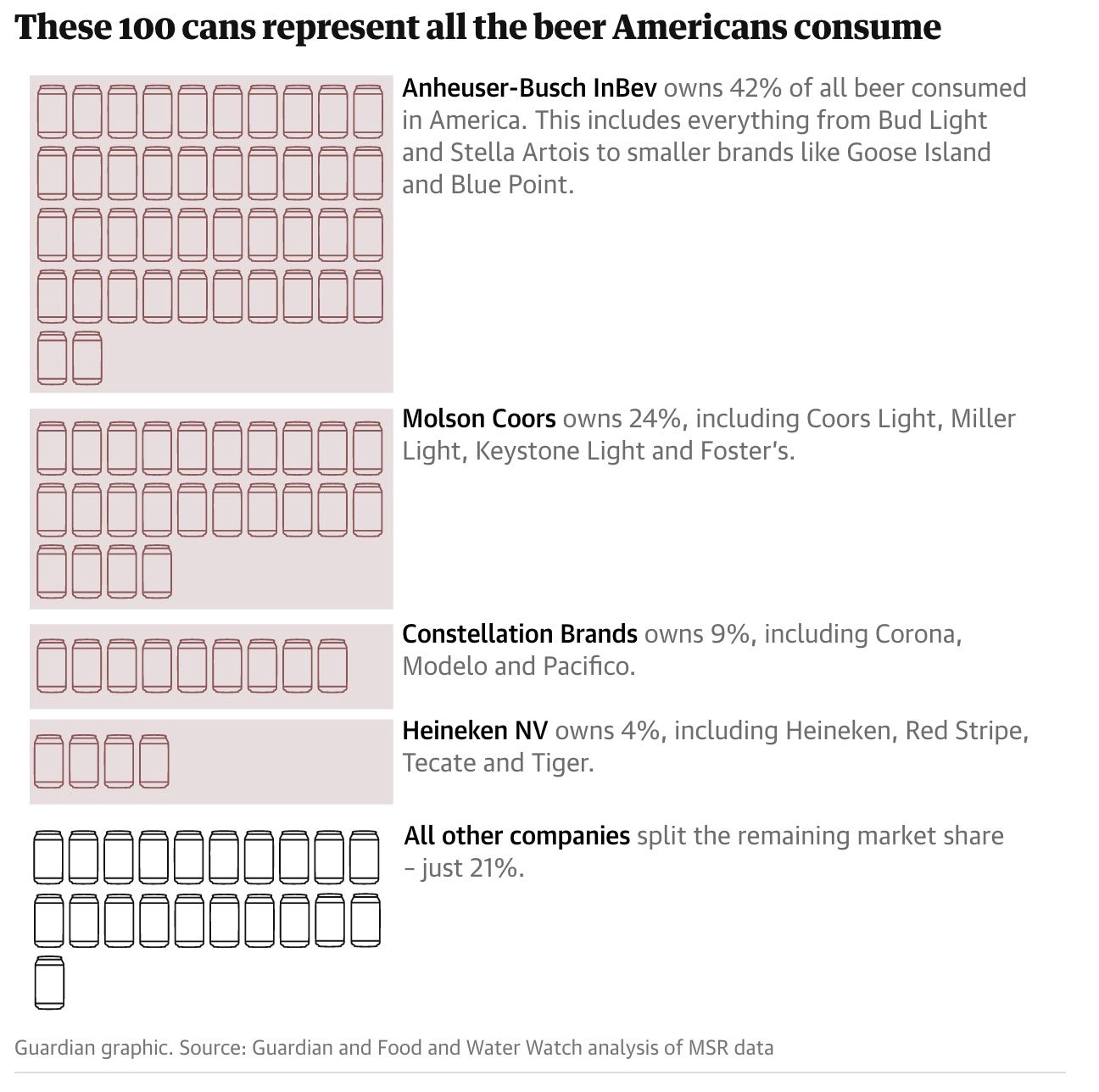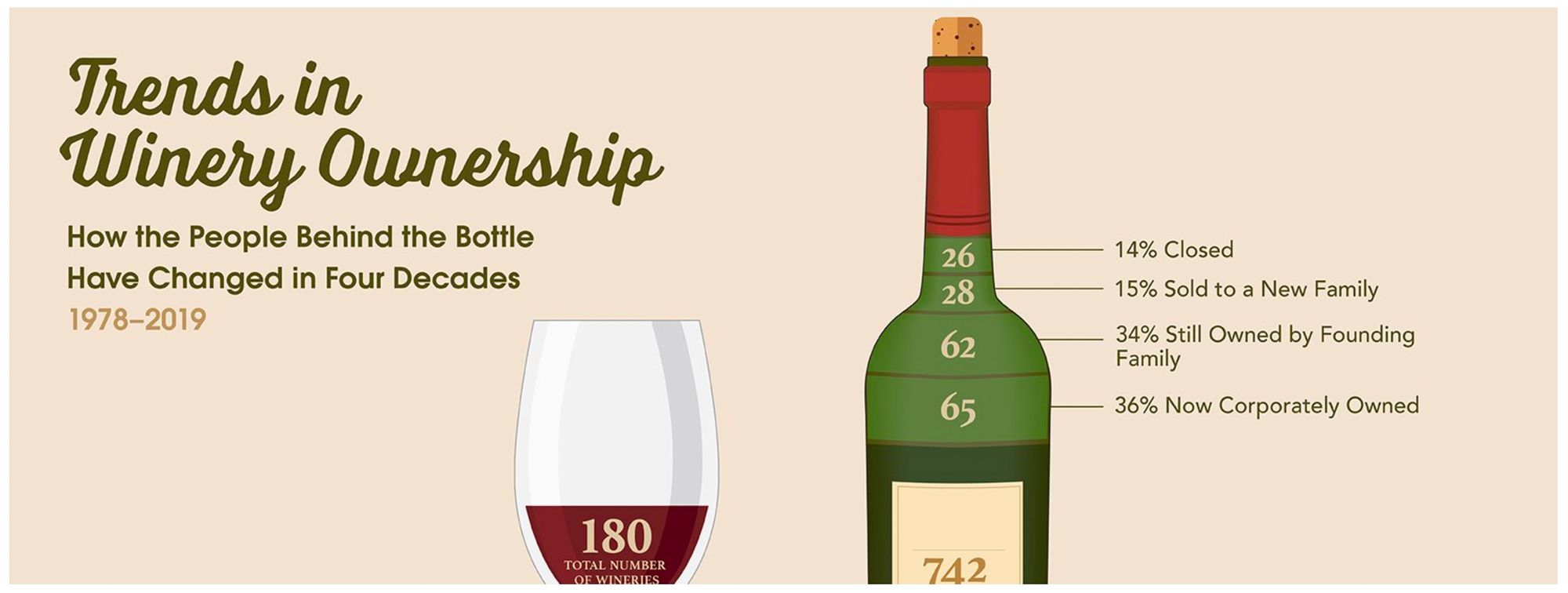The Big Problem with Big Business

I’m a huge proponent of drinking local.
If you follow my Instagram or my YouTube channel you’ll know this, as I make a big deal (a whole YT playlist actually) about finding unique and delicious Midwestern drinks from the beer, spirit, and yes even wine industry.
There are a lot of reasons why I think sticking to local is important (as much as you deem viable - we’re not saints!). Everything from supporting the economy in your area, to keeping small businesses alive, and the climate change impacts of shipping internationally and even domestically.
But I want to focus on one specific reason today: the pervasiveness and effects of corporate ownership in the industry.
I’m going to dive into this topic below, but I want to put a caveat right up front: This is a massive topic, and I am not doing a deep dive. There is so much to unpack in each individual section of the industry, my goal is really just to ensure you get a broad overview and can start ruminating on this on your own.

Who Owns What
The beverage industry is colossal, and there is too much information out there regarding the economics of it. So much so it hurt my brain when I started diving into info like, “which are the biggest corporations/companies in the space?” And “How much of the industry is privately or family owned & operated?”
I quickly learned I am not an economist and hardly a researcher. However, I did manage to learn a few things.
First significant call-out is that each of the three sections of the industry I focus on are vastly different regarding this topic. I write about beer, wine, and spirits (distillation) and each of those areas have different experiences when it comes to the percentage of them being private or family run, though I think it’s safe to say that there is a trend across the board.
To start with, let’s discuss the insane fact that 3/4 of the entire Scotch whisky industry is owned by four companies. JUST FOUR COMPANIES. So every time you get your dram of Glenlivet or Jameson (which I know isn’t Scotch whisky, but it’s more well-known and still fits with this example) your money is actually going to Pernod Ricard, which owns 19% of the total market share.
What about beer? There’s more U.S. craft breweries now than ever before, and they’ve been popping up so quickly in the last decade most of them have to be small, privately owned ones, right? WRONG. 79% of the entire beer industry in the U.S. is owned by just 4 major corporations. And that remaining 21%? That’s not just local family businesses, that’s all other business besides those 4 major big boys!
There is a startling graphic and accompanying article by The Guardian on this topic that’d I’d highly recommend (image below). And, shameless plug, I also wrote an article all about the craft beer boom here, if you’re more interested in some of those numbers.

Of course, we can’t forget about the wine industry. You might think that small wineries are less common, but actually the craft winery scene is gaining a lot of traction in the U.S. (Which leads me to another shameless plug, I just dug into the craft winery scene and posted about it a month ago - article here.)
But just because we now have over 11,000 wineries now in the U.S. doesn’t mean they’re all small or family owned.
In a stunning graphic by Jordan Winery (below),we see a breakdown of the ownership in Sonoma County and Napa Valley between 1978 and 2019. During that time, 36% of wineries were sold to corporations.
Now, those are better numbers than the whisky or beer industry, but it still shows a trend of selling to big business over time.

Zeroing In
Looking at all three industries’ numbers is somewhat mind boggling and too much to keep in my brain, so instead let’s narrow down and do a case study. A wonderful encapsulated look at corporate ownership is to look at Islay, Scotland as an example.
Islay is a small island off the Argyll Coast of Scotland. It’s 239 square miles, with a population of 3,228 persons; so even though it’s the eighth largest island in the British Isles… it’s still small by American standards (ex. I think my husband had more people in his high school than that.)
However, even though it’s small with the population of a midwestern high school, there are NINE major distilleries on the island, with two more set to open in the next few years. That’s huge. It’s like the island is one big whisky factory.
And out of those nine major distilleries, some of which have been in constant use since 1779 when Bowmore first opened, only one of them is still privately, family owned. Even the brand new and most recent distillery to open - Ardnahoe in 2018 - was never privately owned. It was built on a £12 million investment from Hunter Laing & Company, which has been in the whisky buying and bottling business since 1949.

The Islay distilleries all being owned by other major corporations was actually one of the first “pings” of realization for me. My partner and I went on a four-week long trip to Scotland in 2017 and spent a full week on Islay hiking and visiting every distillery on the island (dream trip, I know). We chatted with the tenders and distillers quite a bit, and this is how we came to realize only one of the nine distilleries there was still family owned and run. Besides Ardnahoe, every one of them had started as a family- or community-run business, and now they were all run by off-island major corporations.
What’s more, when we went back to Scotland in 2023 to wander around in the highlands, hiking and distillery hopping (yes, we really like Scotland), we had a very interesting conversation with a bartender at Uile-bheist, a new distillery that just opened in Inverness. He mentioned that several of the distilleries that had previously sold to major corporations were looking to buy themselves back. However, as you can imagine, that is proving to be an almost more insurmountable task than opening a distillery in the first place.
But why are they looking buy out of big business? Wouldn’t it be good to have that much money and knowledge at your back?
The Good, The Bad, and The Ugly
Well, as it turns out, the answer to the latter question above is both yes and no. Of course it lands smack dab in a gray area, because it’s life and nothing is ever clean cut.
There are certainly good aspects to being owned by a larger company. First is the initial payout; craft breweries are in hot demand and some - of course depending on the size - are bought for up to $1 billion. Then of course, there are all the additional resources at one’s fingertips: marketing experts to help with sales, access to larger distributors, major retailers suddenly having space for your craft, and even the possibility of an international market.
There are major success stories from being bought out. A great example is Lagunitas Brewery, which was bought by Heineken in 2015. This isn’t a story of needing to be saved, but one of wanting to grow even bigger. Lagunitas was doing fine on its own; in fact it had opened new locations in Chicago and Seattle just a year prior, but the owner wanted more. The partnering with Heineken opened up the availability of the international market. They now have brewing operations in the UK, Amsterdam, and Brazil, and their beer is sold in 30 different countries.

But it’s not all rainbows and smiles. Being owned by the big guy does not mean that the big guy knows what he’s doing. Nor does it mean you’ll actually get enough of that money we discussed above. As the “old” owner, you no longer have complete control over your recipes, distribution, or business practices. What big brother says, goes.
A great, if somewhat rumored, example of this is the Anchor Brewing Company. I wrote a whole blog post in homage to them and their predicament here, but it’s the rumors swirling around their closure that really gets the gut roiling.
In 2017 the brewery was purchased by the giant Japanese company Sapporo. Rumors abound that this buy-out was what really cemented their path to closure. The brewery had been struggling for a few years before selling, so it’s definitely not the only reason, but workers claim they did not receive the support - monetarily nor managerially - that they needed from the major company. Instead, they were told to fire workers, cut distribution, and stop brewing anything not in their core line. It was mentioned that it was quite obvious the giant company had no experience or information on running a U.S. based craft brewery; they didn’t understand nor care about the local wants or needs, to the detriment of the brewery and the local population who are now without the craft beer that had been there for 127 years.
Weekly Adventure
I don’t want to ask you - or force you - to drink only local. I think while sticking locally might be easier for some types of beverages than others (ahem, beer, ahem) it’s not realistic in “normal, every-day” society to drink only local-made products. (Hell, I couldn’t drink coffee then, since we definitely don’t grow that in Wisconsin, and you don’t want to see me without coffee.)
However, this week I will encourage you to pay attention to what you’re consuming. If your favorite wine is an Italian Sangiovese that you get from a local wine store (points), but who gets that wine through a distributor who works with Diagio… well, join the club. I think a good first step is knowing that; recognizing and being aware of who you’re giving your money to.
So do the tiniest bit of research. Pay attention. Attempt local when you can. Support the little guy. And drink some good beer.
Cheers,
Molly
References
https://en.wikipedia.org/wiki/Ardnahoe_distillery
https://hunterlaing.com/about/story/
https://en.wikipedia.org/wiki/Islay_single_malts
https://www.sfchronicle.com/food/wine/article/anchor-steam-sapporo-18196825.php
https://vinepair.com/articles/sapporo-usa-anchor-brewing-liquidation-analysis/
https://en.wikipedia.org/wiki/Lagunitas_Brewing_Company
https://www.mensjournal.com/food-drink/jim-koch-sam-calagione-boston-beer-company-dogfish-head-merge
https://alcohol.org/guides/the-alcohol-industry-in-data/
https://www.brewersassociation.org/insights/new-owner-demographic-benchmarking-data/